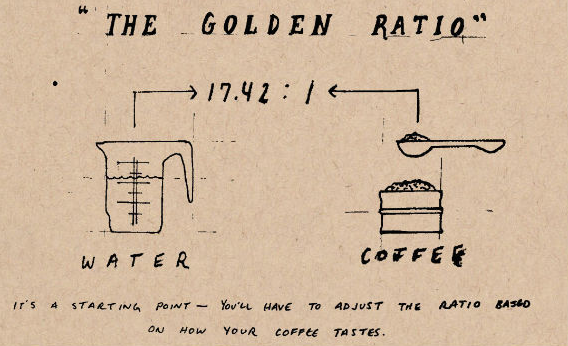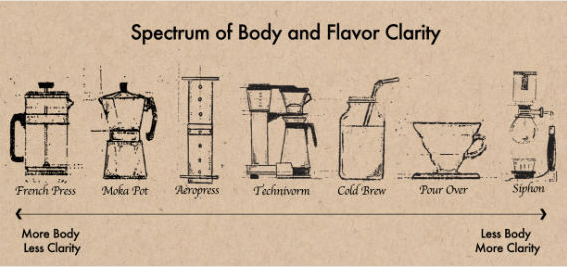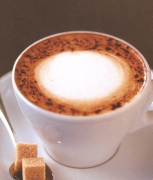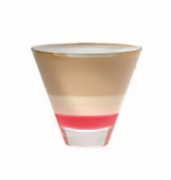Coffee production Technology Coffee extraction rate calculation and Gold Powder-Water ratio Rule
In the study of cup testing or extraction of freshly baked coffee, barista flexibly changes different powder-to-water ratio and baking forms according to different coffee bean characteristics, mainly in order to restore or preserve the original natural flavor and characteristics of coffee. In the manual extraction skill teaching class, artificial preferred quality is adopted, coupled with the quality of fresh baking, which promotes the strong learning atmosphere of coffee classroom. It is like the delicacy extracted by yourself in the cup.
Coffee has been recognized as a necessity of human life. It is no longer a luxury, nor does it represent indulgence, it is the crystallization of human painstaking efforts and abilities.
William H. Yukos, everything about Coffee (1922) We are preparing for a stressful day in Cerf, North Carolina, on November 23, 2010. We stood there bleary-eyed, letting the thin black liquid flow slowly into the Calaf iron bottle.
We are roommates and are both infantry officers of the Marine Corps. Training, battle planning and various war preparations keep us in a state of sleep deprivation forever. At that time, coffee was just a bitter thing that could provide coffee cause, and we just needed it to stay awake.
We overlooked too much of the beauty of coffee.
Several years have passed by in a hurry, and we have returned to the field. Now we are in the kitchen, making coffee. Wonderful coffee.
The kind of coffee that awakens your gratitude for the good life in the first place every morning. It's art, it's ritual, it's time to share around the table.
If you are like us, no one has ever taught you how to properly modulate coffee or how to taste it. When you stop at the local coffee pavilion, everything about coffee is hidden behind the counter, too far away for you to understand. Not long ago, we were like that. But after repeated experiments, we made too many mistakes, and then we finally learned the right way.
What a shame to waste all this time on a bad coffee. If you drink it every day, or if you have to make it for someone else every day, you might as well make coffee a little better. What we want is a good coffee, right?
In fact, what we want is not just a good coffee, but a perfect coffee.
What is a good coffee?
If we want to understand what a good coffee is, we first need to know the standard of its cooking technology in the IEEE world. After all, if you want to determine whether your coffee can be classified as a good product, it is helpful to have a standard as a reference.
Measuring the quality of coffee dates back to the 1950s. At that time, E.E., a professor in the Department of Chemistry at MIT. Lockhart conducted a series of surveys to study American taste preferences. In general, he surveyed many people who drank coffee and asked them about their preferences.
Lockhart published his research results with a "coffee cooking control chart", showing what the best coffee was in the minds of Americans at that time.
Years later, the American Professional coffee Association (SCAA) confirmed that American tastes had not changed much. For Americans at least, the perfect coffee is the coffee with an extraction rate of 18%-22% and a total solid solubility of 1.15%-1.35%.
Confused by technical terms? Please don't do this.
The extraction rate refers to the amount of coffee particles extracted from the original dry coffee residue. The total solubility of solids represents the actual percentage of coffee solids in a cup of coffee (commonly known as "cooking strength").
Put this information together and you get the coffee cooking control chart, in which the central area highlights the optimal combination of cooking intensity and extraction rate.
Our purpose of modulating coffee is to achieve perfection. Everyone seems to be bragging about their unique and mysterious process of achieving the best extraction rate, but we're here to tell you that it's no big deal.
Instead, the key is based on the golden ratio of 1 coffee to 17.42 parts of water. This ratio best takes you to the best area, and there is no unit limit, which means it's up to you whether you want to be in grams, ounces, pounds, quartz stones or tonnage units.
Therefore, if you want to prepare coffee with an extraction rate of 20% and a total solid solubility of 1.28%, you can use 30g of dry coffee and 523g of water as the base, and then adjust it on this basis.
At the same time, the concepts of extraction rate and total dissolution of solids are often mistakenly confused. It is important to figure out the difference between the two concepts.
Cooking strength refers to the amount of solid coffee dissolved in your coffee. And the extraction rate indicates the amount of extract you get from dry coffee. The point is that strong coffee has nothing to do with bitterness, coffee content or baking curve, only with the ratio of coffee to water in your cup.
The measurement methods of all these values were greatly innovated in 2008. A company called Voice Systems Technologies decided to apply the refractometer principle-- a refractometer is an instrument used to detect light waves refracted by particles-- to a project and developed a coffee concentration analyzer called ExtractMojo.
This instrument can accurately display the total solid solubility of coffee, and then compare it with the "coffee cooking control chart", you can not only scientifically but also pay attention to taste to prepare a better coffee.
Some purists object to using such a device to measure the quality of a coffee, which reminds us, as retired Marines, of a similar topic, which is the discussion of gun control.
Is there something wrong with the gun itself, or is it the way people use the gun?
Is there something wrong with the concentration analyzer, or is there a problem with the way people use this instrument?
These issues have triggered heated discussions, and the starting point of the discussion is good. But guns and concentration analyzers are tools, and like other tools, they can be used inappropriately.
Let's look at this in terms of the "fortress principle" (castledoctrine): just use a concentration analyzer quietly at home.
The basic principles of cooking coffee
Once you figure out what a good coffee is and how you measure it, it's much easier to learn to cook coffee.
The six basic principles are:
1. Choose high-quality coffee beans: please choose sustainable whole bean coffee, which will be baked within a few weeks after picking. And if you want to join the coffee revival movement thirdwave, which is now popular in the United States, choose lightly baked coffee beans so that you can really taste the unique flavor of coffee.
Deep baking will make coffee beans lose these flavors. We know it sounds strange to say, but deep-baked coffee beans are like a steak that is not bad but has been baked beyond recognition.
two。 Freshly ground coffee before cooking coffee: baked coffee beans are fragile and perishable. Coffee contains more aroma components than red wine, but these aroma components will deteriorate quickly after oxidation.
Freshly ground coffee before cooking coffee can retain the original taste of these ingredients. Want to make your self-tuning coffee taste better, this is the most important point.
3. Store coffee correctly: coffee beans that are not used immediately should be stored in an airtight container to avoid sunlight. There are many disputes in the coffee circle about whether coffee should be refrigerated or not.
We can compromise. Coffee beans that will not be used within two weeks can be refrigerated; beans that will be used within two weeks do not need to be refrigerated.
4. Match coffee and water correctly: a common mistake is that there is not enough coffee. We are reluctant to give up-it always feels like a waste to put an extra spoonful of coffee. But the golden ratio we mentioned earlier is definitely an important starting point for making a good coffee and the easiest way to achieve this goal.
5. Focus on skill: discussing how to cook each coffee step by step is beyond the scope of this article, but there is a common fact behind all methods that making a good coffee requires accuracy and coordination.
Each cooking method has some special skills, but after repeated practice over and over again, you can correct your mistakes and make more and more progress.
6. Use premium tools: coffee cooked with premium tools tastes better than bargains from the discount area. Yes, these tools are more like upfront investments, but they are worth it in the long run. High-quality tools have a longer service life and make the whole process of cooking coffee much easier.
Classic fine-tuning methods:
With these principles in mind, you can choose a coffee cooking method, and all cooking methods should consider only these factors: one is the mellow thickness of coffee, the other is the purity of coffee flavor, and the change of the combination of the two. The balance between alcohol thickness and purity depends in part on the coffee beans used to make this cup of coffee.
When we were just getting in touch with all this and were not familiar with coffee, it was a pity that no one could explain why the coffee made by the French filter press (Frenchpress) was so mellow, or why the hand-made coffee (pourover) could have such a pure taste.
The answers to these questions are tried to hide. We only see the appearance of these puzzles and put the questions aside for the time being.
At last we found the answer to the question by chemical method. Chemically speaking, substances in the world are divided into two categories: soluble substances and insoluble substances. The soluble particles extracted from coffee powder produce the unique flavor and smell of coffee, while the main function of insoluble particles is to make coffee feel mellow.
Baked coffee beans are made up of these two particles, so how to balance the two ingredients during extraction determines what your coffee will end up like.
Do you prefer coffee, which is full-bodied and sandy? Try the French filter press. Looking for pure citrus flavors that highlight South American soy beans or coffee with African coffee soy milk flavor? Take a look at the hand punch machine.
Everyone has their own preferences, but as long as you choose the cooking method, you can further fine-tune the coffee by adjusting these variables:
The grinding particle size of 1.coffee beans: the grinding particle size affects the surface area of the particles, and then affects the extraction rate. The surface area of coarse ground coffee beans is smaller than that of fine ground coffee beans, which makes it more difficult for water to permeate or extract coffee solids.
Uniform grinding size means that the extraction rate of oil and acid in coffee is equal, so that there are no large particles that are not fully extracted or small particles that are overextracted. This is why coffee experts always advocate the purchase of a high-quality disc grinder. You know what? They're right.
two。 Water temperature: because when the temperature is higher, the solid dissolves faster, so the temperature affects the extraction rate. In addition, the temperature determines which solid dissolves, which in turn affects the taste. Too high water temperature will make coffee sour, because the high temperature will release bad-tasting acidity from coffee beans.
Therefore, we recommend that you use water of 195 to 202 degrees Fahrenheit to boil coffee. Remember, this refers to the actual temperature of the coffee, not the water temperature. There is usually a difference between the two.
3. The number of times to stir the coffee residue during cooking: you can stir the coffee residue as the water passes by to further control the cooking process. Stirring is useful because it increases the diffusion rate of dissolved coffee solids in water, allowing coffee slag to come into contact with water more quickly.
But stirring also has the effect of lowering the water temperature, which we know will affect the cooking process. But at the end of the day, it's just a skill you can master over and over again.
The ratio of 4.coffee to water: it's a bit strange to come back to this point, isn't it?
But the key difference here is that when you deploy coffee, you don't have to strictly follow the golden ratio. Instead, adjust it according to your own taste. To make deployment easier, buy a balance. Compared with measuring capacity, the results of measuring the weight of coffee and water will be more accurate.
Last point. A good coffee teacher will tell you to make sure to adjust only one variable at a time so that you can accurately observe the results. Adjusting two variables at a time will confuse the result, and you will not know whether you changed the X variable or the Y variable, causing the change of the result.
This is not a complex space science.
Although we talk a lot about the concepts of chemical reactions, particles, molecules and extraction rates, cooking good coffee is more an art than a science. Once you have mastered the rules behind the cooking process, you can develop a method that works best for you.
That's the charm of coffee. When we first entered this field, we were so embarrassed that we knew nothing about most of the basic knowledge. The selection of materials, processing, and appliances are all coming, and we have no way to start at all.
But soon, we will find ourselves climbing along the path of coffee study. It doesn't take a lifetime to cook a good coffee. It is a hobby that we can practice and cultivate on Saturday morning. As we keep groping and the situation is good and bad, we sometimes get into a dilemma and don't know what to do. We spent a lot of time. We wasted a lot of coffee.
Although we read as many books as we can, sometimes we are stubborn, ignorant and blind, there will always be a few days when we make mistakes because we do not understand and do not follow the skills taught by others.
However, if you take a fall, you will gain wisdom. We have summed up which methods are not effective. There is always something new to try, and we grow up naturally without a plan.
For us, this is a long-term practice, we have been learning, there is always room for improvement, exploration and innovation.
Most of the knowledge related to coffee has existed for a long time, and modern people have been exploring coffee for more than a hundred years. So now it's our turn to join this coffee learning trip.


[ratio of gold powder to water: 1 coffee to 17.42 parts of water]

[gold cup rule: perfect coffee is coffee with an extraction rate of 18%-22% and a total solid solubility of 1.15%-1.35%]
Important Notice :
前街咖啡 FrontStreet Coffee has moved to new addredd:
FrontStreet Coffee Address: 315,Donghua East Road,GuangZhou
Tel:020 38364473
- Prev

Fancy Coffee making Technology Italian Coffee making method
Chocolate cappuccino Cappuccino Con Cacao [material]: Espresso30 ml, cocoa powder amount, steam foam 120ml [production method]: 1. Extract the Espresso Solo and inject it directly into the cappuccino cup. two。 Sprinkle with cocoa powder first. 3. Then pour in the steam foam. Two: Fredo mocha Mocha Freddo [material]: double cup extraction concentrated
- Next

Fancy Coffee Cafe Cafe's New year products
One: cherry blossom love Sakura Moment ① 15ml cherry syrup ② 10ml red pomegranate syrup ③ 100ml milk ④ 80ml light cream ⑤ cream proper production method: pour the syrup into a latte cup, pour in the hot milk and light cream, and finally add the milk foam. Two: hazelnut almond tea latte Hazelnut Almond tea latte ① 15ml hazelnut syrup ② 10ml bitter
Related
- What is the meaning of lactic acid fermentation with coffee bean treatment?
- How to judge the state of foam by sound?
- How does the latte pull out the unicorn pattern? Come to get for a little trick to improve the flower pull!
- Will flower pulling affect the taste of the latte?
- Do you know the history of coffee?
- The difference between honey treatment and sun washing what is raisin honey treatment?
- What kind of milk can a novice use to make coffee foam to keep the foam longer? The correct method and skills of milking tutorial sharing
- Why do washed coffee beans taste sour? Flavor characteristics of washed Coffee
- Introduction to the skill of how to practice the size and height of water injection around the circle of hand-brewed coffee
- How do beginners practice coffee flower drawing from scratch?

